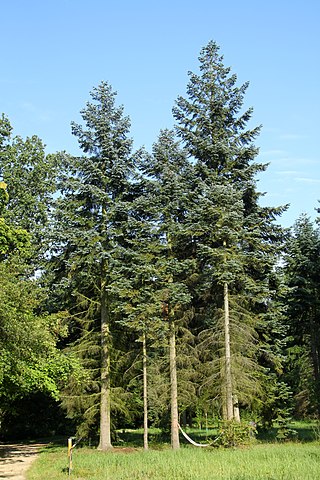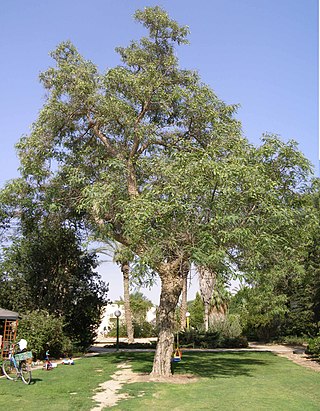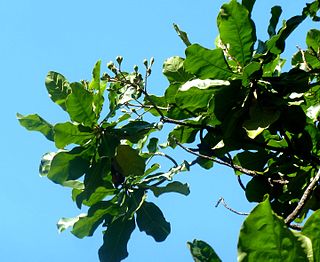
Quercus robur, the pedunculate oak or English oak, is a species of flowering plant in the beech and oak family, Fagaceae. It is a large tree, native to most of Europe and western Asia, and is widely cultivated in other temperate regions. It grows on soils of near neutral acidity in the lowlands and is notable for its value to natural ecosystems, supporting a very wide diversity of herbivorous insects and other pests, predators and pathogens.

Gunnera is the sole genus of herbaceous flowering plants in the family Gunneraceae, which contains 63 species. Some species in this genus, namely those in the subgenus Panke, have extremely large leaves. Species in the genus are variously native to Latin America, Australia, New Zealand, Papuasia, Hawaii, insular Southeast Asia, Africa, and Madagascar. The stalks of some species are edible.

Ficus benjamina, commonly known as weeping fig, benjamin fig or ficus tree, and often sold in stores as just ficus, is a species of flowering plant in the family Moraceae, native to Asia and Australia. It is the official tree of Bangkok. The species is also naturalized in the West Indies and in the states of Florida and Arizona in the United States. Its small fruit are favored by some birds.

Anthocleista is a genus of tree- and shrub-like tropical plants in the subtribe Potaliinae in the Gentian family. There are between 14 and 16 species in the genus, native mainly to tropical Africa, including Madagascar and the Mascarene Islands. Anthocleista was once placed in the family Loganiaceae, but more recent molecular, morphological, and phytochemical evidence has placed the group well within the Gentianaceae.

Drosera capillaris, also known as the pink sundew, is a species of carnivorous plant belonging to the family Droseraceae. It is native to the southern United States, the Greater Antilles, western and southern Mexico, Central America, and northern South America. It is listed as vulnerable in the US state of Virginia, and critically imperiled in Arkansas, Maryland, and Tennessee.

Calotropis procera is a species of flowering plant in the family Apocynaceae that is native to Northern and Tropical Africa, Western Asia, South Asia and Indochina. It typically reaches a height between 6 feet (1.8 m) to 8 feet (2.4 m), and rarely to as high as 15 feet (4.6 m), and grows in sunny to partly-shaded habitats such as disturbed and overgrazed lands, rangeland, roadsides, river flats and coastal dunes. Its green fruits contain a toxic milky sap that is extremely bitter and turns into a latex-like substance, which is resistant to soap.

Abies procera, the noble fir, also called red fir and Christmas tree, is a species of fir native to the Cascade Range and Pacific Coast Ranges of the northwestern Pacific Coast of the United States. It occurs at altitudes of 300–1,500 meters (980–4,920 ft).

Alluaudia procera, or Madagascar ocotillo, is a deciduous succulent plant species of the family Didiereaceae. It is endemic to south Madagascar.

Quercus faginea, the Portuguese oak, is a species of oak native to the western Mediterranean region in the Iberian Peninsula. Similar trees in the Atlas Mountains of northwest Africa are usually included in this species, or sometimes treated as a distinct species, Quercus tlemcenensis. It occurs in mountains from sea level to 1,900 metres above sea level, and flourishes in a variety of soils and climates. Out of all the oak forests in the Iberian Peninsula, the southern populations of Portuguese oak were found to have the highest diversity and endemism of spider species.

Tipuana tipu, also known as tipa, rosewood and pride of Bolivia, is a South American tree.

The azure-hooded jay is a species of bird in the family Corvidae. It is found in Middle America. Its natural habitat is subtropical or tropical moist montane forest. This species is known to have four subspecies. It is 11 to 12 inches in length and is dark blue with a black head and upper chest. The back of the head and neck are sky blue with a white border.

Anthocleista grandiflora is a species of flowering plant of the family Gentianaceae. It is commonly known as the forest fever tree. It is a tall, slender tree up to 30 m with a preference for forests in high rainfall areas. The leaves are very large, up to 100 cm x 50 cm, arranged in terminal clusters.

Bridgeoporus is a fungal genus in the family Polyporaceae. A monotypic genus, it contains the single polypore species Bridgeoporus nobilissimus, first described to science in 1949. Commonly known both as the noble polypore and the fuzzy Sandozi, this fungus produces large fruit bodies that have been found to weigh up to 130 kilograms (290 lb). The upper surface of the fruit body has a fuzzy or fibrous texture that often supports the growth of algae, bryophytes, or vascular plants.

Quercus geminata, commonly called sand live oak, is an evergreen oak tree native to the coastal regions of the subtropical southeastern United States, along the Atlantic Coast from southern Florida northward to southeastern Virginia and along the Gulf Coast westward to southern Mississippi, on seacoast dunes and on white sands in evergreen oak scrubs.
Anthocleista madagascariensis is a species of plant in the Gentianaceae family. It is a tree that is widespread throughout the evergreen forests of Madagascar.
Anthocleista djalonensis is a species of plant in the Gentianaceae family. It is a small tree that is found from West Tropical Africa to South Chad.
Anthocleista nobilis, commonly known as cabbage tree, candelarum, and cabbage palm, is a species of plant in the Gentianaceae family. It is a tree that is found from West Tropical Africa to Angola.
Anthocleista liebrechtsiana is a species of plant in the Gentianaceae family. It is a small tree that is found from West Tropical Africa to the Caprivi Strip.
Anthocleista inermis is a species of flowering plant in the Gentianaceae family. It is a small tree that has been found from the Central African Republic and the Democratic Republic of the Congo
Anthocleista laxiflora is a species of plant in the family Gentianaceae. It is a vulnerable climbing plant that is endemic to Central Africa.















